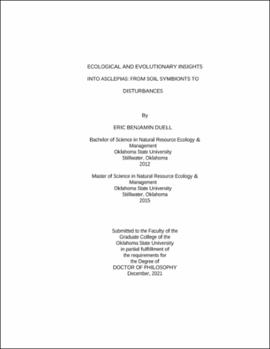| dc.description.abstract | Milkweeds (Asclepias) are a diverse genus of plants in the family Apocynaceae, with an estimated 130 species found in North America. Milkweed research has increased dramatically over the past two decades, due in part to its importance as the primary food source of monarch (Danaus plexippus) larvae. Reductions in milkweed availability in grasslands of central North America are contributing to D. plexippus population declines. While research assessing the biology of milkweeds has gained recent attention, the interactions of milkweeds, associated soil symbionts, and ecosystem disturbances on milkweed abundance remain unknown. I conducted two interrelated studies to assess the role of phylogenetic relatedness in plant-soil-microbial interactions of various milkweed species, and two additional studies assess the effects of disturbances on individual plants and on long-term abundances in tallgrass prairies. My data highlight the role of phylogenetic distance in influencing PSFs between sympatric congeners. Relative mycorrhizal responsiveness (rMR) of selected milkweeds varied greatly between species, ranging from 27 to 97%. While there was remarkable variation in the degree of responsiveness within the genus, twenty-four of thirty-five species produced significantly greater (p </= 0.05) biomass following inoculation with arbuscular mycorrhizal (AM) fungi, compared to soil without AM fungi. Results also suggest that, due to longer shared evolutionary histories, it is likely that closely related species share a greater overlap of mutualist partners, compared to species with earlier divergence. My research also found productivity, plant defenses, and floral resources of tallgrass prairie forbs that are important for pollinating insects can be significantly reduced by drought, although responses to drought were species-specific. However, abundances of AM fungi associated with milkweeds were relatively unaffected by drought. My research shows long-term abundances of Asclepias viridis, the most abundant milkweed species in the region, are reduced by fire, grazing, and woody cover, while less common species were relatively unaffected. Generally, milkweeds are unaffected by drought at various temporal scales. Milkweeds are an important component of native plant communities, feeding not only monarch larvae, but also providing nectar for countless pollinator species. My research is a testament to the unseen interconnectedness within ecosystems, from soil symbionts to disturbances. | |
